Introduction
The sales process steps are a fundamental framework that drives revenue generation for businesses across industries. Recent studies highlight its critical importance, with organizations that follow a defined sales process seeing an 18% increase in revenue growth compared to those without one (HubSpot, 2023). Understanding and implementing the steps in the sales process is crucial for success.
While the exact number of sales process steps can vary, many experts advocate for a 5-step sales process that encompasses the essential elements of closing deals effectively. Research shows that companies with clearly defined sales process steps achieve 33% higher revenue than those with an ad-hoc approach (Salesforce, 2022).
Among the various steps in the sales process, prospecting and closing are often cited as the two most crucial steps. A survey by Sales Insights Lab (2023) found that 40% of sales professionals consider these two sales process steps to be the most challenging and impactful.
Interestingly, businesses that regularly review and optimize their sales process steps see a 28% improvement in win rates (Gartner, 2023).
This underscores the importance of not just implementing a sales process, but continually refining the steps to adapt to changing market dynamics and customer preferences.
So continue reading to know more the mastering the sales process steps and the required essential steps to close more deals.
Understanding the Sales Process Steps
If you want to close more deals, it’s essential to have effective sales process steps in place. The sales process refers to the series of steps a sales team takes to move a potential customer from initial contact to a closed sale.
In this section, we'll dive into what a sales process is, why it's essential to have a well-defined process and the benefits of having streamlined sales process steps.
What is a Sales Process?
A sales process is a systematic approach to selling that involves a series of steps designed to move a potential customer from initial contact to a closed sale.
The specific sales process steps in the sales process may vary depending on the salesperson's approach, the target audience, and the industry.
However, there are generally five steps of the sales process: prospecting, qualifying, presenting, closing, and following up. These five sales process steps combine to create a comprehensive sales process that, when followed effectively, leads to increased sales and revenue.
Importance of Well-Defined Sales Process Steps
Having well-defined sales process steps is essential for several reasons:
Firstly, sales process steps give structure to your sales efforts, making it easier to track progress and identify areas for improvement.
Secondly, sales process steps ensure that everyone in your sales team is working towards the same goal and following the same approach.
Finally, sales process steps help you identify what works and what doesn't when it comes to closing deals, allowing you to refine your approach and increase your success rate.
Benefits of Streamlined Sales Process Steps
Streamlined sales process steps can bring several benefits to your business.
Firstly, sales process steps can help you generate more leads and close more deals, which will increase your revenue.
Secondly, sales process steps can improve your team's productivity by reducing time-wasting activities and ensuring everyone is working efficiently.
Finally, streamlined sales process steps can enhance your customer experience, as sales process steps ensure that every prospect receives a consistent and well-thought-out sales pitch.
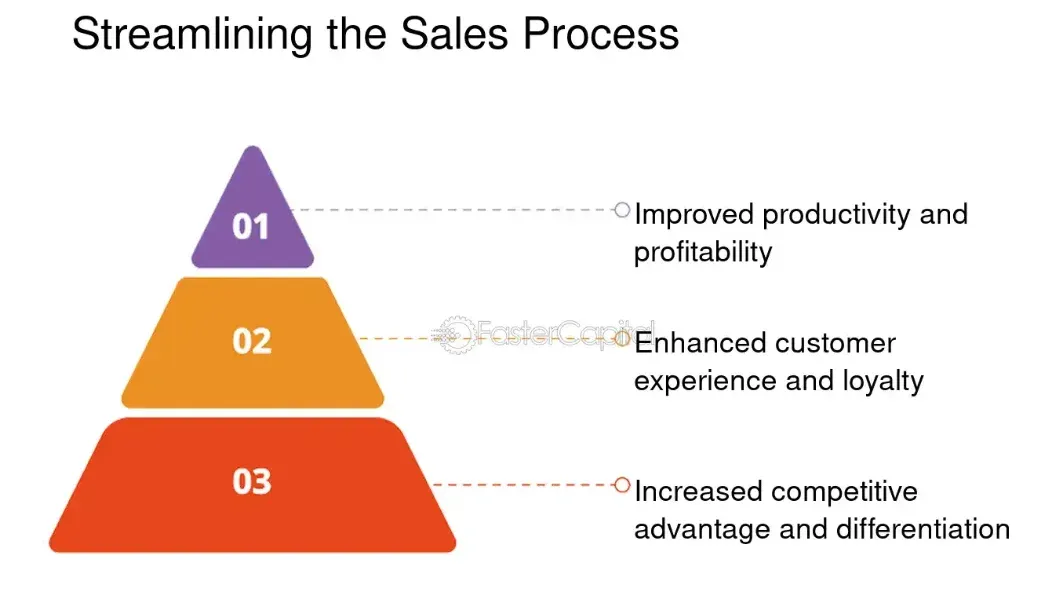
Building a Strong Foundation
Now that you understand what sales process steps are and why it's essential, we'll dive into the sales process steps you can take to build a strong foundation for your sales efforts.
Defining Your Ideal Customer
Before you can sell effectively, you need to understand who your ideal customer is and what they need. Creating detailed customer personas can help you get a better sense of who your target audience is and what motivates them to make a purchase.
To create effective personas, you'll need to conduct research, gather data, and analyze your audience's behavior patterns.
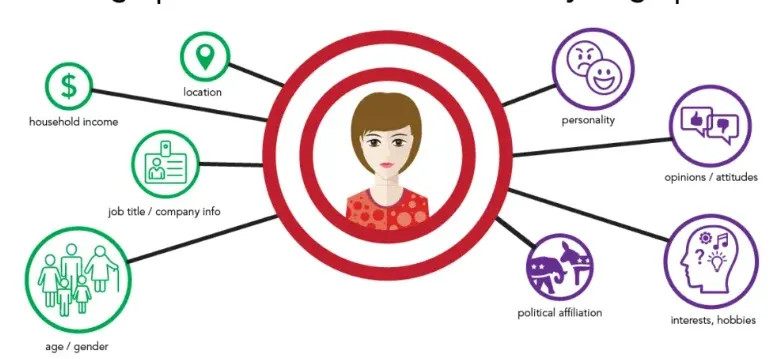
Understanding Customer Pain Points and Needs
Identifying your customer's pain points and needs is essential for crafting an effective sales pitch. By understanding what challenges your customers are facing and what they need, you can tailor your message to resonate with them.
This will make them more likely to engage with your sales team and eventually make a purchase.
Setting Clear Sales Goals
To measure the success of your sales efforts, it’s essential to set clear sales goals. The SMART goal-setting framework can help you create goals that are specific, measurable, achievable, relevant, and time-bound.
Aligning your sales goals with your overall business objectives can help ensure that your sales team is working towards the same goal and focused on achieving the company's broader mission.
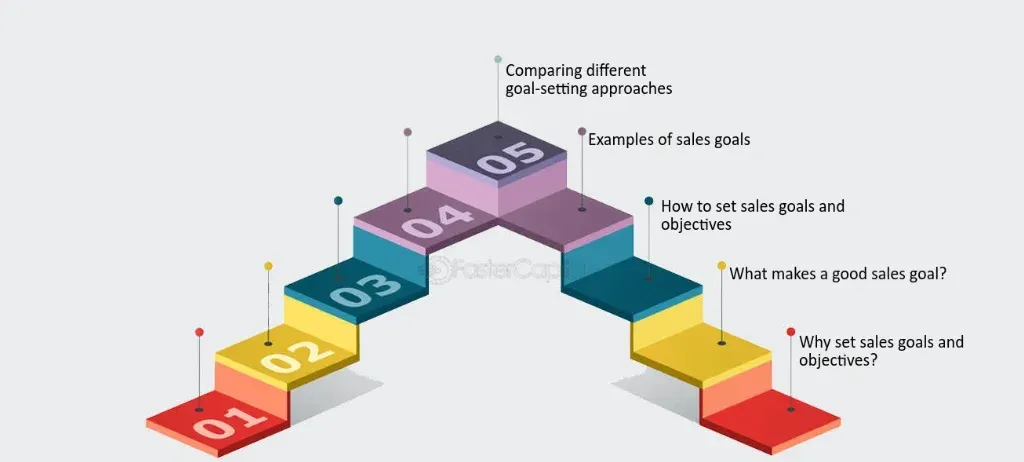
Mastering the Sales Process: Essential Steps to Close More Deals
A successful sales process steps involve a series of strategic steps that guide a potential customer from initial contact to a closed deal.
Let's break down each stage of the sales process steps and explore key tactics to maximize your sales efforts.
Prospecting and Lead Generation
Dive into the art of finding and attracting potential customers – the lifeblood of sales process steps.
Effective prospecting techniques: Prospecting is the foundation of any successful sales effort. By identifying and reaching out to potential leads, you lay the groundwork for future sales.
Utilize tools like social media, networking events, and industry databases to identify potential prospects.
Suggested Reading:The Handy Insider's Guide to Lead Generation and Management
Building a high-quality lead pipeline: A well-nurtured lead pipeline is crucial for consistent sales success.
Ensure your pipeline is filled with qualified leads who align with your ideal customer profile. Regularly review and update your pipeline to prioritize high-quality leads.
Using chatbots for initial lead qualification: Chatbots can streamline the lead qualification process by automating initial interactions and collecting key information. Implement chatbots on your website or messaging platforms to engage with leads promptly and qualify them efficiently.

Lead Qualification and Prioritization
This sales process steps talks about how to separate the wheat from the chaff and focus your efforts on the most promising leads.
Lead scoring and grading: Implement a lead scoring system to prioritize leads based on their level of engagement and fit with your product or service.
Assign scores to different actions and behaviors to identify the most promising leads for further nurturing.
Lead nurturing strategies: Nurture leads through personalized communication and valuable content that addresses their specific needs and challenges.
Build rapport and trust over time to guide leads through their decision-making process and increase conversion rates.
Leveraging chatbot interactions for lead scoring: Use chatbots to automate lead scoring based on interactions and responses.
Chatbots can engage with leads, collect relevant data, and provide insights that help you identify qualified leads more efficiently.
Building Relationships
Discover this sales process steps to fostering trust and rapport with your prospects, laying the groundwork for successful deals.
The art of effective communication: Establishing strong relationships with prospects requires clear and empathetic communication.
Listen actively to understand their needs and pain points, and tailor your messaging to address their specific concerns.
Active listening and understanding customer needs: Effective sales professionals prioritize listening over talking.
By actively listening to your customers, you can uncover valuable insights that inform your sales approach and demonstrate your commitment to meeting their needs.
Enhancing customer interactions with chatbots: Chatbots can enhance customer interactions by providing instant responses, personalized recommendations, and seamless support.
Integrate chatbots into your communication strategy to improve the customer experience and build stronger relationships.
Product Demonstration and Value Proposition
Master the sales process steps and techniques of showcasing your product's unique benefits and aligning them with your customer's needs.
Crafting compelling product demonstrations: Showcase the unique features and benefits of your product through engaging demonstrations. Highlight how your product solves customer problems and adds value to their business or life.
Positioning your product as a solution: Position your product as a solution to your customer's challenges by emphasizing how it addresses their pain points and delivers tangible benefits. Tailor your value proposition to resonate with your customer's specific needs.
Using chatbots for product information and demos: Integrate chatbots into your website or messaging platforms to provide instant product information and guided demos. Chatbots can answer common questions, showcase product features, and assist customers in making informed purchase decisions.

Handling Objections
Equip yourself with sales process steps and strategies to address concerns and turn potential roadblocks into opportunities.
Common sales objections and responses: Anticipate and address common sales objections with confidence and empathy.
Prepare responses that overcome objections and position your product as the best solution for your customer's needs.
Turning objections into opportunities: View objections as opportunities to educate customers and clarify misconceptions. Use objections as a chance to deepen your understanding of customer concerns and tailor your responses to address their hesitations effectively.
Training chatbots to address common objections: Train chatbots to handle common objections by providing scripted responses and relevant information. Chatbots can assist in addressing objections promptly and guiding leads toward a positive purchasing decision.
Closing the Deal
Explore effective techniques to guide your prospect towards a positive decision and secure the sale.
Different closing techniques: Explore a variety of closing techniques to seal the deal effectively. From assumptive closes to trial closes, experiment with different approaches to find the most suitable method for each sales situation.
Overcoming closing anxiety: Sales professionals often face closing anxiety when it comes to sealing the deal. Stay confident, focus on the value your product offers, and guide customers towards making a confident purchasing decision.
Using chatbots to provide additional information during the closing process: Leverage chatbots to provide additional information, answer last-minute questions, and facilitate a smooth closing process. Chatbots can offer instant support and reassurance to customers during the final stages of the sales cycle.
Post-Sale Follow-up and Customer Retention
Uncover the often-overlooked sales process steps to ensure customer satisfaction and pave the way for future business
Importance of customer satisfaction: Prioritize customer satisfaction by following up after the sale to ensure a positive experience. Solicit feedback, address any concerns promptly, and show your commitment to customer success.
Building long-term customer relationships: Focus on building long-term relationships with customers by staying engaged, providing ongoing support, and demonstrating your value beyond the initial sale. Create a loyal customer base by exceeding expectations and delivering exceptional service.
Utilizing chatbots for post-sale support and feedback: Implement chatbots for post-sale support to handle customer inquiries, provide order updates, and gather feedback on their experience.
Chatbots can enhance customer retention by offering seamless post-sale assistance and demonstrating your dedication to customer care.
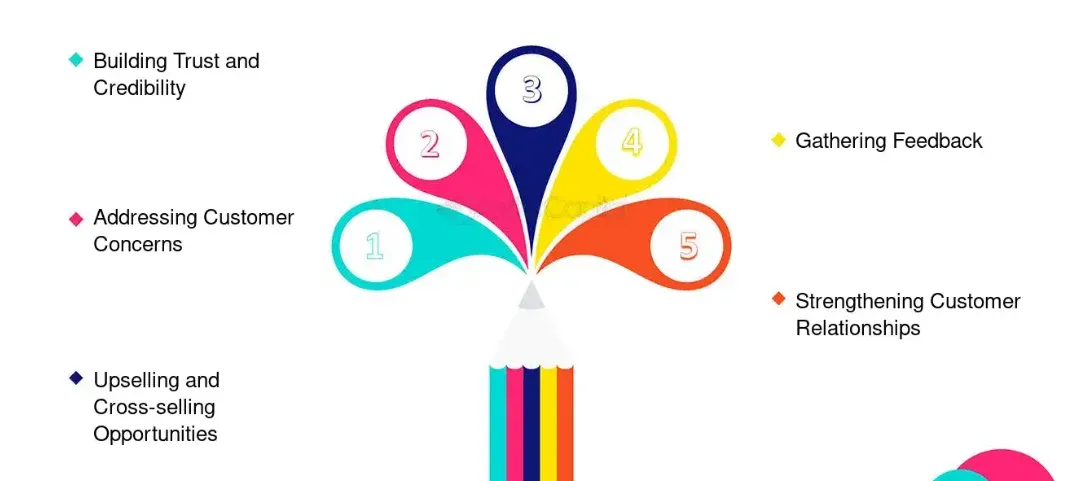
Optimizing the Sales Process Steps
The sales process is a critical part of business success. Optimizing the sales process steps involves assessing its performance, utilizing technology and automation, and continuously training sales teams.
In this section, we will focus on three critical aspects of optimizing the sales process steps: sales process metrics and analysis, sales technology and automation, and continuous sales training and development.
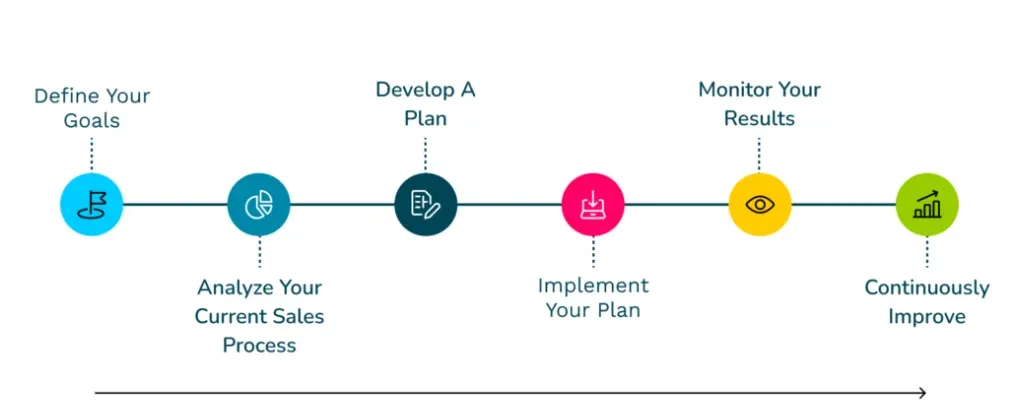
Sales Process Metrics and Analysis
Tracking and analyzing key sales metrics is an essential step in optimizing the sales process. It provides insights into how well the process is performing and where improvements can be made.
Key sales metrics to track: There are several sales metrics businesses should track, such as lead-to-customer conversion rates, average sales cycle length, and customer lifetime value.
By tracking these metrics, businesses can identify areas where improvements can be made and adjust their sales strategy accordingly.
Using data to improve performance: Successful sales teams use data-driven insights to optimize their sales process continuously.
By analyzing data, teams can identify patterns, pinpoint areas for improvement, and make adjustments to the sales process steps to increase conversions.
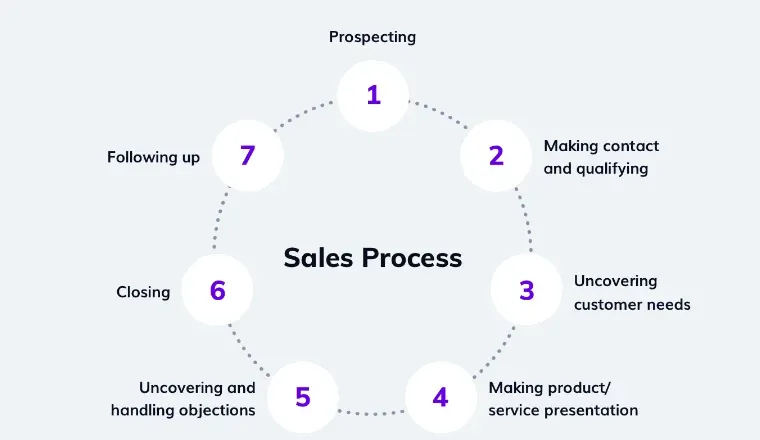
Analyzing chatbot interactions for performance insights: Chatbots can be a valuable source of performance insights in the sales process steps.
By analyzing chatbot interactions, businesses can gather insights into the most common customer inquiries, the effectiveness of chatbot responses, and the areas where chatbots require improvement.
Sales Technology and Automation
Incorporating technology and automation into the sales process can increase efficiency, reduce costs, and improve sales results.
CRM and sales automation tools: Customer relationship management (CRM) software and sales automation tools can streamline the sales process, from lead generation to post-sale follow-up.
These tools can automate repetitive tasks, prioritize leads, and provide real-time insights into the sales pipeline.
Leveraging technology for efficiency: Sales teams can leverage technology to improve efficiency in the sales process.
For example, using email templates, automating follow-up emails, and scheduling appointments can speed up the process and free up more time for sales efforts.
Integrating chatbots into the sales tech stack: Chatbots can be integrated into the sales tech stack to offer customers instant support and information.
They can interact with customers around the clock, offer personalized product recommendations based on customer data, and help to close deals more efficiently.
Continuous Sales Training and Development
Continuous training and development are essential to grow sales teams' capabilities and improve their sales performance.
Importance of ongoing sales training: The sales process changes frequently due to changes in markets, technology, and consumer behavior. Sales teams must continuously update their skills to remain competitive and efficient.
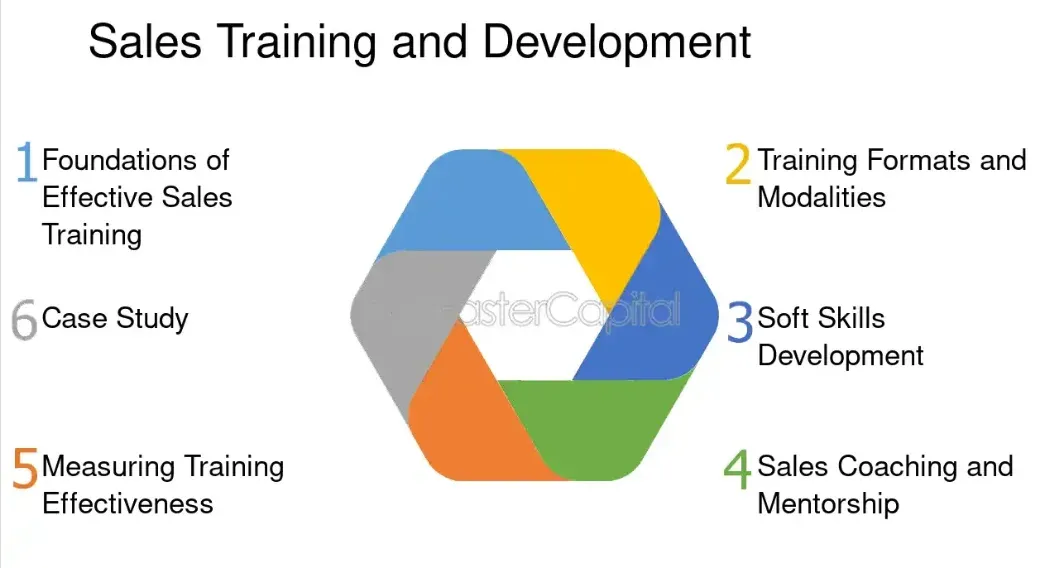
Developing a sales training plan: Sales managers should develop a comprehensive sales training plan that includes onboarding new hires, ongoing training, and refresher training.
A well-designed training plan should include both online and offline components, such as workshops, role-playing exercises, and eLearning modules.
Training sales teams on effective chatbot usage: Sales teams should receive training on effective chatbot usage to maximize their benefits.
Chatbots must be integrated seamlessly into the sales process, and sales teams need to understand how chatbots work, how to use them for lead qualification, and how to analyze chatbot performance data.
Conclusion
In conclusion, mastering the sales process steps is crucial for businesses aiming to boost their conversion rates and revenue. The sales process steps, when executed effectively, create a roadmap for success that can significantly impact a company's bottom line. Whether you're following sales process steps or a more elaborate framework, understanding and optimizing each stage is key to closing more deals.
Remember, while prospecting and closing are often cited as the two most critical sales process steps that are part of the sales process, every step plays a vital role in guiding potential customers towards a purchase decision.
From initial contact to follow-up, each interaction contributes to building trust and demonstrating value.
To enhance your sales process, consider leveraging technology solutions like BotPenguin. This platform can automate and streamline various sales process steps, from lead qualification to customer support, allowing your team to focus on high-value activities that require a human touch.
Ultimately, the most effective sales process is one that's continually refined based on data and customer feedback.
By regularly analyzing your performance at each step and making necessary adjustments, you can create a dynamic, responsive sales strategy that adapts to changing market conditions and customer needs, ensuring long-term success in your sales efforts.
Frequently Asked Questions(FAQs)
What are the key sales process steps?
The key sales process steps typically include prospecting, lead qualification, product demonstration, handling objections, closing the deal, and post-sale follow-up.
How can technology enhance the sales process?
Technology can enhance the sales process by providing tools for lead tracking, customer relationship management, automation of tasks, and data analysis to improve sales performance.
How important is continuous sales training in the sales process?
Continuous sales training is crucial for refining sales skills, keeping abreast of market trends, and adapting to changes, ultimately leading to more effective and efficient sales processes.
What are the benefits of using chatbots in the sales process?
Chatbots can provide instant customer support, qualify leads, provide product information, and streamline the sales process, resulting in improved customer experience and increased sales efficiency.
What are the essential sales metrics to track for performance optimization?
Key sales metrics to track include lead-to-customer conversion rates, average sales cycle length, customer acquisition costs, customer lifetime value, and sales pipeline velocity.
How can data analysis improve sales performance?
Data analysis can identify trends, patterns, and gaps in the sales process, enabling businesses to make data-driven decisions, refine their strategies, and ultimately improve sales performance.



